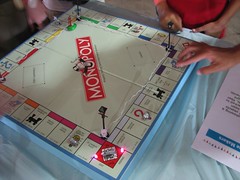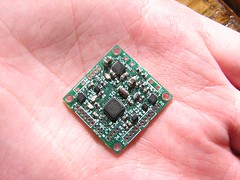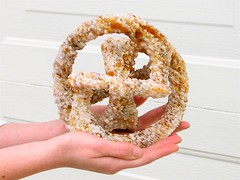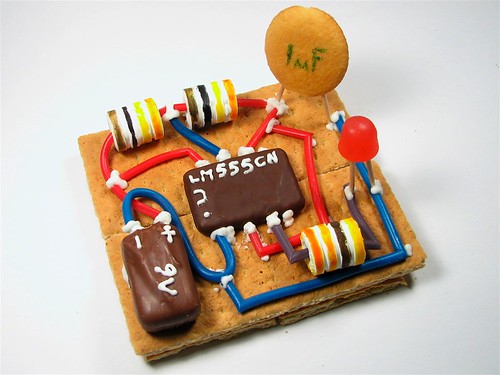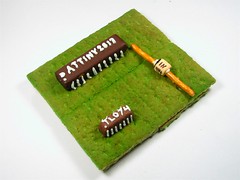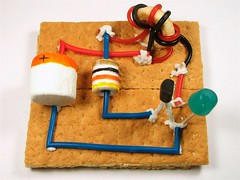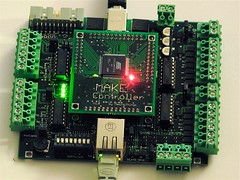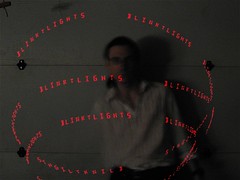
Starting next week and over the next few months, I’ll be teaching several different self-contained microcontroller-oriented classes at TechShop, at different levels of skill and with different emphases:
- Soldering Project: Build a Micro Readerboard
- Soldering Project: Build an AVR Programmer
- Seminar: Introduction to AVR Microcontrollers
The classes are held at TechShop, a San Francisco Bay Area “open-access public workshop,” located just off of 101 in Menlo Park, where you can go use a wide range of tools to make things, and take all kinds of classes.


Soldering Project: Build a Micro Readerboard
This is a fun little soldering class, suitable for anyone with a bit of soldering experience (even youngsters), where you can customize the phrases in and build your very own LED Micro-Readerboard. It’s a cute little thing that spells out a preprogrammed messages (e.g., your name), one letter at a time, on a single-character alphanumeric display. In the class, you get to choose what messages to put on your readerboard, solder it together and take it home. It’s a neat, self-contained project that’s a great example of what you can do with a little AVR microcontroller. This is an intermediate soldering class; a little bit of prior soldering experience is assumed. The class typically runs about 90 minutes, but soldering experts will finish more quickly and we’ve reserved space for two hours just in case. Class size is limited to 5 students.
This class is scheduled to be given
- Saturday, 2/9/08 1:00 PM
- Saturday, 2/23/08 4:00 PM
- Saturday, 3/8/08, 1:00 PM
- Saturday, 3/22/08, 4:00 PM
Sign up here.
And speaking of AVR Microcontrollers….
Seminar: Introduction to AVR Microcontrollers
 AVR microcontrollers are powerful and versatile single-chip computers that cost only a few dollars each. You may have noticed that a number of our interesting projects are based around these, using them to make smart little toys and machines.
AVR microcontrollers are powerful and versatile single-chip computers that cost only a few dollars each. You may have noticed that a number of our interesting projects are based around these, using them to make smart little toys and machines.
This class is aptly billed by TechShop as “How To Use AVR Microcontrollers in Your Projects.” Indeed. We’ll be bringing along a number of our cool AVR-based Evil Mad Scientist Laboratories projects from to show off some of the things that you can do with these little marvels, and how you might go about doing it.
Formal class description: “AVR microcontrollers are powerful, versatile and inexpensive single-chip computers that are remarkably easy to program in C, using entirely free and open-source tools that run on Macs, Windows, and Unix-like operating systems. In this practical introduction to AVR microcontrollers, we’ll take it from the beginning so that you can get started using them for your own cool projects. Some topics to be covered include: different types of AVRs and how to pick one for your application, getting a programmer, installing software tools, how to get started actually programming them, and how to download and run your code on the microcontroller. Class format is a one hour lecture followed by show-and-tell demonstrations and ample time for questions.”
This class is scheduled to be given
- Tuesday, 2/5/08 6:30-8:30 PM
- Saturday, 2/23/08 1:00-3:00 PM
- Monday, 3/3/08, 6:30-8:30 PM
- Saturday, 3/22/08, 1:00-3:00 PM
And speaking of programming….
Soldering Project: Build an AVR Programmer
 In this class you will solder together, test out and get to take home a USB programmer for AVR microcontrollers. With this hardware tool and free cross-platform software, you can use your computer to write code for and program these little one-chip wonders.
In this class you will solder together, test out and get to take home a USB programmer for AVR microcontrollers. With this hardware tool and free cross-platform software, you can use your computer to write code for and program these little one-chip wonders.
This is an Intermediate Soldering Project; you must have prior soldering experience. You are encouraged, but not required, to bring a laptop along. (If you do bring your computer, you should have a chance to install the necessary software and test it out with your new programmer.)
Class size is limited to 5 students.
This class is scheduled to be given
- Saturday, 2/9/08 4:00-6:00 PM [Full!]
- Sunday, 2/24/08 2:00-4:00 PM — Just added!
- Saturday, 3/8/08, 4:00-6:00 PM [Full!]
Sign up for these and other TechShop classes here.





